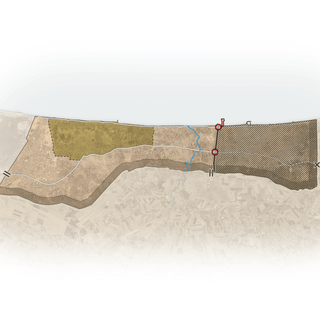


How Israel is reshaping the Gaza Strip
InvestigationWhile the future governance of the Palestinian enclave is being debated within the Israeli government, the armed forces have systematically destroyed buildings along at least 1 kilometer of the border, creating a militarized corridor that isolates Gaza City.
In seven months of war, the Israeli army has reshaped Gaza to suit its needs. It has razed buildings in a "security zone" about a kilometer deep on the border, threatening to permanently deprive the narrow coastal strip of 16% of its territory, including agricultural land, according to satellite data analyzed by Le Monde. The army has forced hundreds of thousands of Gazans to leave the northern part of the enclave and has secured a militarized road that prevents their return, while limiting the passage of humanitarian aid.
The army is conducting raids from two forward bases set up along this corridor. It is also building new structures on the coast, intended to secure the delivery of aid by sea, promised by the American ally for the beginning of May. "Israel presents these structures as temporary, but they represent faits accomplis that could last for a long time," fears a Western diplomat.
The Israeli right intends to turn the ruined metropolis of Gaza into a depopulated buffer zone in the north, or to recolonize it. Israeli ministers from the center, who are in the minority, see the return of Gazans to the north as a lever in ongoing negotiations with Hamas, to force it to release its hostages. A proposal to this effect was made in Cairo, Egypt, at the end of April, according to the Lebanese newspaper Al-Akhbar and Israeli army radio. It could lead to Israeli forces withdrawing, at least temporarily, from the road running through the middle of the enclave.
However, all components of Israel's ruling coalition are calling for long-term "freedom of action" for the army in Gaza. They agree that a "stabilization" phase must continue for many years after the war, requiring regular raids against Hamas and the armed brigades in Gaza.
A buffer zone at the border
Israel systematically destroyed buildings along a kilometer-wide strip of land on the Gaza border by bombing from October 2023, followed by the deployment of sapper teams from November. This "security zone" covers much of the enclave's agricultural land, which before the war produced around 20% of its food needs. It extends over the no-man's-land – previously 100 meters wide – that borders the wall breached by Hamas commandos on October 7, 2023, causing the death of 1,200 Israeli civilians and soldiers. It also covers the former patrol path and military observation posts set up by the Islamist movement in front of the wall.
In several places, this zone exceeds 1 kilometer, as in the Shujaiya neighborhood, where entire sections were razed to the ground on the edge of the Gaza metropolis, and as in the destroyed southern village of Khuza'a. From the start of the conflict, right-wing Israeli politicians spoke of the need to "punish" Gaza by cutting off part of its territory. Eli Cohen, then foreign affairs minister, declared that "the territory of Gaza will also decrease." Israel first mentioned this plan to Arab states in December 2023.
You have 74.59% of this article left to read. The rest is for subscribers only.








